Since the dawn of time, people have been drawn to fires. They provide us warmth and ambient light, plus the satisfying crackle that we associate with cozy, intimate moments with our loved ones.
When you think about sitting outside and enjoying a fire, do you imagine yourself gathered around the hearth teaching your kids how to build and stoke the fire properly, or are you the busy type who just wants to press a button, and miraculously have a fire? In this article, we’ll share the pros and cons of gas and wood-burning fireplaces to help you figure out which is right for your outdoor space.
Gas Outdoor Fireplaces
Gas fireplaces are a common convenience in modern homes, and they use gas to light the burners located inside your fireplace (similar to your traditional gas stove). There are many choices for realistic looking logs, and using them is as simple as pressing a button on a remote.
Can you picture yourself hauling logs to the fireplace and stoking the fire now and into your golden years? Gas fireplaces tend to be better for those who have reached the point where they can’t or don’t want to haul heavy logs and stand hunched over to tend a fire.
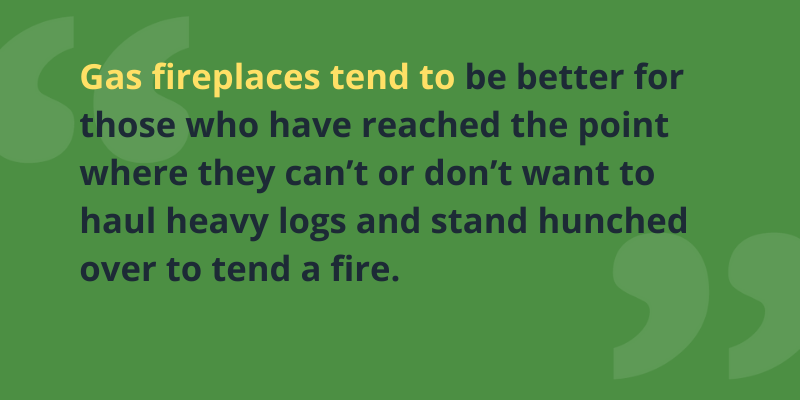
Pros of Gas Outdoor Fireplaces
Gas fireplaces are growing in popularity for many reasons.
Cleanliness
Gas fireplaces are clean in two senses of the word – debris and gas.
Both propane and natural gas fireplaces are clean-burning, which means that they’re better for the environment than wood-burning fireplaces. Gas fireplaces don’t produce any smoke or ash, and there’s no need for you to change out any of the wood inside the fireplace. Instead, when you’re done with your fire, just turn off the ignition switch.
Quick startup
When you’re short on time, wouldn’t you rather be able to come right home from work, grab a drink, and immediately relax by the fire? To start a gas fireplace, you first check for debris and overall cleanliness and then turn on the ignition switch. That’s it!
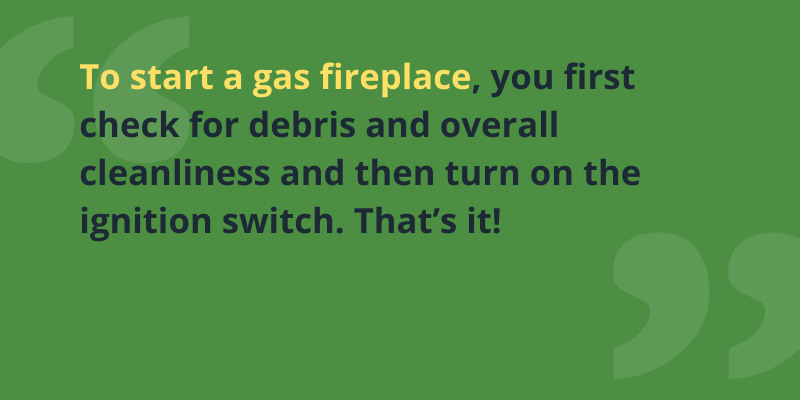
Space efficient
Gas fireplaces burn cleanly, so there is no need for you to have a chimney unless you want one. If you’re low on space, you can still have a beautiful outdoor fireplace.
Better air quality
Gas fireplaces burn fuel cleanly and produce fewer pollutants than burning wood — 99% less, in fact! Gas fireplaces are a great choice for people with asthma or other breathing challenges. Plus, they’ll never spark at you!
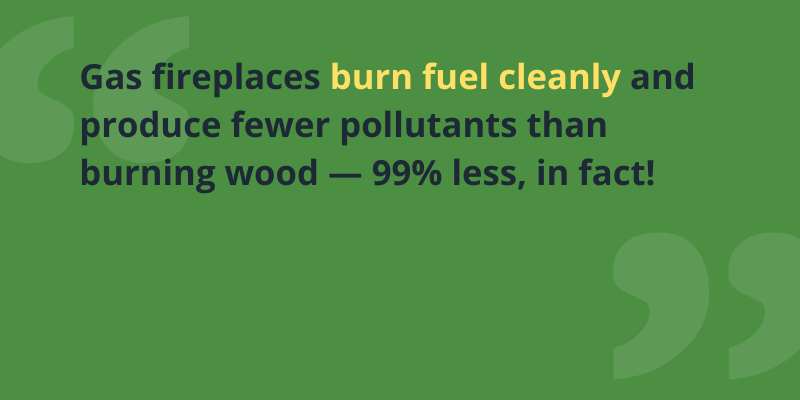
Less expensive upon installation
There is a striking difference in the cost of installing a gas versus wood-burning fireplace. Depending upon the size and design, a wood-burning fireplace installation can cost from $8,500 to $22,000, while a gas fireplace can cost much less.
Less expensive annual cost
You don’t have to purchase any materials for a gas fireplace since it’s already hooked up to its power source, the gas line. A wood-burning fireplace requires wood, a fire poker, and other fireplace accessories. On average, running a gas fireplace costs around $60 annually, while a wood-burning fireplace costs about $200 each year.
Cons of Gas Outdoor Fireplaces
Despite their convenience, gas fireplaces may not be right for all homeowners.
Lack of ambiance
Do you enjoy the ambiance of a real fire? For most people, getting heat from the fireplace is only one element that they look for. Many also want the ambiance of a real fire, and a gas-powered one just isn’t quite the same as the real thing.
Before you pick a gas fireplace, make sure that you won’t miss the natural wonders of a wood-burning fireplace, such as the sound of crackling embers and the subtle scent of burning wood.
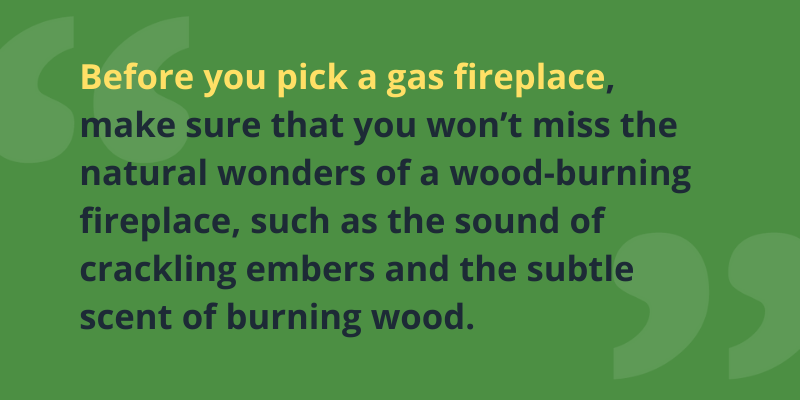
Needs a gas line
Though you don’t need a chimney to make a gas fireplace work, you’ll have to run a gas line to the fireplace. If your home isn’t currently set up for gas, the installation will cost a little time and money.
Wood-Burning Outdoor Fireplaces
Do you want to bring some of the “great outdoors” to your home and enjoy a genuine fire with real logs? Then a wood-burning outdoor fireplace may be for you.
If you choose a wood-burning fireplace now but think that you might want to convert it to gas in a few years, we can do a partial gas line installation now. If you don’t opt for the install initially and decide to convert it later anyway, we’ll have to remove some stone. You’ll save money in the long run if you install a partial gas line from the start.
Pros of Wood-Burning Outdoor Fireplaces
Wood-burning fireplaces are a classic addition to any outdoor space.
Natural ambiance
Are you drawn to a real fire? Modern gas fireplaces have realistic looking logs that give the feel of natural fire, but nothing beats the real thing. With a wood-burning fireplace, you truly get the whole experience from listening to the logs crackle to watching the fire die down to a glowing ember.
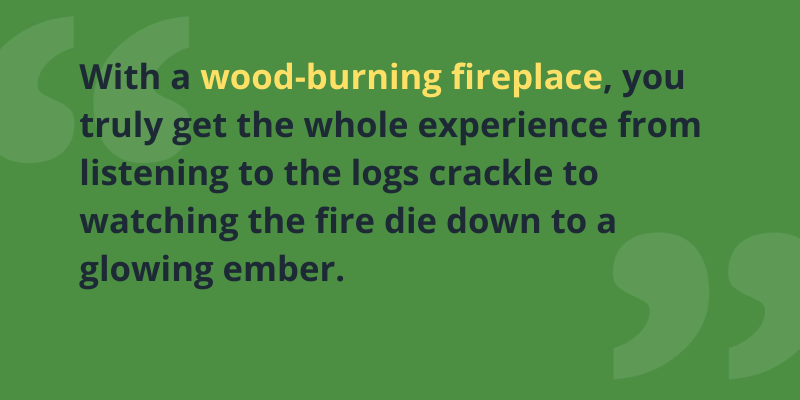
Works anytime
With a wood-burning fireplace, you can have a fire at any time. You don’t have to worry about power outages, fuel levels, or pilot lights. As long as you have wood, kindling, and a lighter, you’re ready to enjoy a fire.
Cons of Wood-Burning Outdoor Fireplaces
While wood-burning fires offer unparalleled ambiance, they’re also more work than a gas fireplace.
Messy
Don’t you already have enough messes to clean up in your home? Wood-burning fireplaces can add to your workload because they require a lot of cleanup. A byproduct of a wood-burning fireplace is ash, and ash can become cumbersome and spread if you don’t clean your fireplace regularly.
Longer startup time
Starting a wood-burning fire takes a lot of effort.
First, you have to make sure that there’s a bed of ashes from the last fire because it makes the fire hotter and insulates the firebox. Then, you have to check the chimney for any blockages and lay the wood and tinder. You also have to open the damper, prime the flue, ignite the fire, and keep adding logs to maintain it all evening.
Annual cleaning
To ensure that your wood-burning fireplace is safe for you and your family, you have to schedule an annual fireplace inspection and creosote removal. Gas fireplaces should also have their vents annually inspected, but the process is usually quicker and cheaper.
Which will you choose?
Which setup lights your fire? Are you the natural, wood-burning type of family, or do you prefer the quick convenience of a gas fireplace? No matter which you choose, you’ll no doubt spend hours enjoying the flicker and family time beside your outdoor fire feature.
Get in touch with a Green Okie design expert to begin designing the outdoor fireplace that’s ideal for your space, your needs, and your lifestyle.



Recent Comments